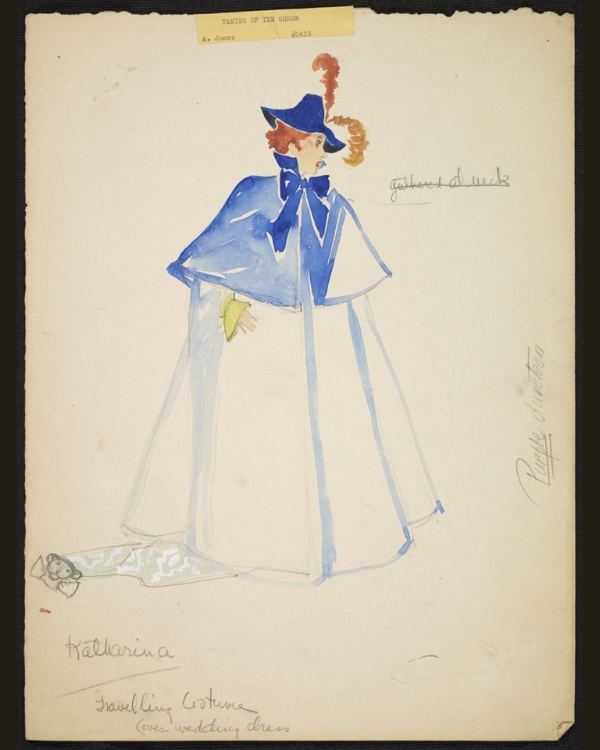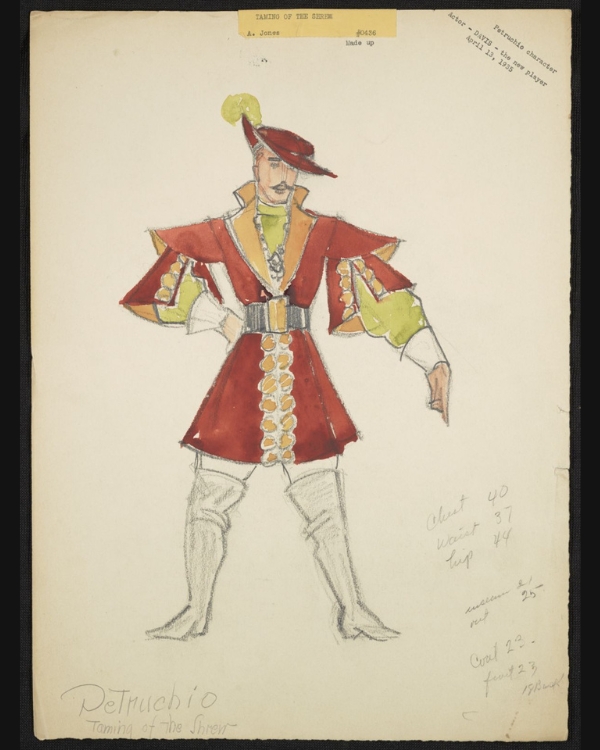The Match and the Tinder Box
Shakespeare is justly celebrated for his comic heroines; among the most beloved are Rosalind from As You Like It, Viola from Twelfth Night, and Beatrice from Much Ado About Nothing. These are spirited, enterprising women who find themselves in a pickle and rely on their wits to get themselves out of it. Their reward, as everyone who has watched a rom-com knows, is marriage with a mate of their own choosing—a happily ever after’ granted to few propertied gentlewomen of Shakespeare’s age.

Read against these Shakespearean ‘sisters,’ Katherine of The Taming of the Shrew comes across as something of a cipher. She certainly shows high spirits when she defies the men who tell her what to do, including her father (Baptista), her suitor (Petruchio), and her (bogus) music teacher (Hortensio). And she more than holds her own in her battle of wits with Petruchio, proving herself at least half deserving of the mock-praise with which he launches his mock-suit: “hearing of her beauty and her wit, … I am bold to show myself” (51-4). But how are audiences to judge the happiness of her marriage when they are given no account of what Katherine wants?
At odds with everyone, Katherine has no companion to talk with; the play provides her with no cousin or nurse or clown to hear her complaints and approve her stratagems. Unlike the heroines of other comedies, and unlike her husband and ‘tamer,’ Petruchio, she has no soliloquies either. She doesn’t even have any asides—an intriguing difference from her namesake in The Taming of A Shrew, an anonymous play written at about the same time with a very similar plot. Especially notable in that play is Kate’s interjection after she accuses her father of palming her off on a “brainsick man” whom they have only just met: “But yet I will consent and marry him / For methinks I have lived too long a maid” (3.169-70). Given that women’s only path to any measure of autonomy depended upon acquiring a household of their own to manage, this character makes the practical choice to wed while she can and hope for the best. When she goes on to balk at her husband’s every demand, she does it not because she is unwilling, but because she wants to test his mettle and prove “his manhood’s good” (172).
For reasons that scholars can only guess at, Shakespeare withholds from The Taming of the Shrew’s heroine any such expression of interior life. This silence forces actors, directors, and spectators to draw their own conclusions. Indeed, one reason the play has remained such a mainstay of the professional stage is the opportunity it provides the production to decide why Katherine transforms from a “shrew” to a compliant wife.
Does she recognize in Petruchio a kindred spirit? By featuring two characters who are boisterous disturbers of social norms, the play whets the expectation that beneath all their wrangling, the couple is well-matched. Petruchio defies masculine convention by showing no interest in Bianca, while Katherine breaks with feminine propriety by showing no interest in conforming to the silent, demure, and obedient archetype that Bianca performs so well. This complementary relation is built into the couple’s lexicon. Petruchio is called “marvelous forward” (meaning over-bold and impertinent) while Katherine is “wonderful froward”(an archaic word meaning backward and perverse), implying, perhaps, that each brings the other’s slanted disposition into balance (2.1.76; 1.1.70). Or as Freud might put it, were he alive and on social media today, each syncs with the other’s kinks.

For many of the play’s readers and watchers, what militates against this sense of tacit affinity is Katherine’s final speech, in which she harangues her fellow brides on women’s ‘natural’ subservience. As far back as Mary Pickford’s 1929 turn in the role, the scene has tended to be played with a wink, detaching the content of the speech from the pose of submission. But how much can irony accomplish when Katherine’s declaration of dependence (“Thy husband is thy lord, thy life, thy keeper” [5.2.162]) draws directly from English common law? Such a gesture is moot in a world in which she has no right either to choose or to eschew her ‘kept’ and curbed position.
And what should spectators take from the fact that Katherine’s silence on the cause of her transformation upholds Petruchio’s warning to his fellow suitors: “Be patient, gentlemen. I choose her for myself / If she and I be pleased, what’s that to you?” (2.1.306-7)? In other words, what goes on between a husband and a wife lies beyond other people’s understanding. This maxim, still in force today, may sound reasonable enough. But it requires taking Petruchio’s word for it when he says that Katherine’s consent (“she and I be pleased” has somehow been secured for his “rough” conduct (“for I am rough and woo not like a babe” [2.1.36]), despite her clear and obvious protests throughout the play, and despite his announced policy of misconstruing Katherine’s behavior to his own advantage:
Say that she rail, why then I’ll tell her plain
She sings as sweetly as a nightingale (2.1.169-70)
By seeding these concerns, the play lets spectators wonder whether by looking on approvingly at the comedy’s (ostensible) happy ending, they are acquiescing to a false reality. Are they heedless bystanders to a regime that calls the sun the moon, and tells old men they are young budding virgins? Are they, like Katherine, gaslit?
This discomfort may be the play’s point. Given that The Taming of the Shrew’s titular subject is “Taming,” and not Katherine or Petruchio, what it puts under scrutiny is not the fate of its characters, but the mock practice of wives’ domestication. Katherine and Petruchio are fictions, after all. But the controversy around marriage, via its sanctification of a union that is at once wholly subsuming (men and women are made “one flesh”) and yet fiercely unequal, has real and ongoing ramifications. As the scholar Frances Dolan has written in her important book, Marriage and Violence, this model of matrimony is a tinder box. Shakespeare, a gifted commercial writer, lights the match.
ELLEN MACKAY is an Associate Professor in the Department of English Language and Literature and the Committee on Theater and Performance Studies at the University of Chicago. She works on Shakespeare and early modern English drama, with a focus on theater theory and material performance. She is an affiliate faculty member in the Digital Studies Program, and has two projects on the go using computational methods to analyze and preserve theatrical matter. Her current book project is on theatricality and domestication on the Shakespearean stage, and this spring, she will be teaching a course in the English/Theater and Performance Studies departments called Shrews! Unladylike Behavior on the Stage and on the Page in Early Modern England.